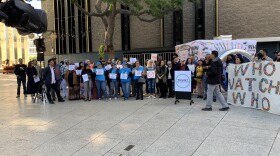- ←Go back to Voter Hub
- What is the primary election about?
- How do I know if I live in District 1?
- How do I register to vote?
- Can I pre-register to vote or register to vote as a noncitizen who has a social security number?
- How can I vote by mail?
- Why is the voting process in California a month long? And is voting by mail safe?
- What do I do if I receive a duplicate ballot?
- How can I get the ballot in my language?
- How can I reduce the flood of election mailers in my mailbox?
What is the primary election about?
This special runoff general election will fill former supervisor Nora Vargas’ vacant seat for San Diego County’s First Supervisorial District. The elected supervisor will serve the remainder of the current term, which ends in January 2029.
The two candidates are Imperial Beach Mayor Paloma Aguirre and Chula Vista Mayor John McCann.
For KPBS' nonpartisan guide, visit the KPBS Voter Hub.
How do I know if I live in District 1?
District 1 spans from the Pacific Ocean on the west to the Otay and San Miguel mountains in the east, and from Barrio Logan in the north to the U.S.-Mexico international border on the south. The First Supervisorial District includes the cities of Chula Vista, Imperial Beach, National City, and some communities within the City of San Diego, such as Barrio Logan, East Village, Golden Hill, and more. Additionally, District 1 includes the unincorporated areas of Bonita, East Otay Mesa, Lincoln Acres, Sunnyside and La Presa.
How do I register to vote?
You can register to vote or check your registration status on the California Online Voter Registration page. The last day to register to vote for the general election is June 16.
➡ To register online you will need the following:
- Your state driver's license or identification card number
- The last four digits of your social security number
- Your date of birth
If you missed the registration deadline, you can still register conditionally and vote provisionally at the registrar’s office or any vote center located in the First Supervisorial District. You can learn more here.
You can find more information at the Registrar of Voters Election Information site.
Here are the key dates and times for early and last-day voting:
- June 2 Ballots go out to registered voters in District 1. In-person voting begins at Registrar of Voters office.
- June 3 Ballot drop boxes open
- June 16 Deadline to register to vote
- June 21 Vote centers open
- July 1 Election Day
Can I preregister to vote or register to vote as a noncitizen who has a social security number?
Preregistration is available to eligible 16 and 17-year-olds. Once a voter turns 18, their voter registration will automatically become active. However, you must be a U.S. citizen in order to pre-register or register.
How can I vote by mail?
County election offices will begin mailing ballots to active registered voters by June 2. Just fill your ballot out, seal it in the provided envelope and send it off to your county elections office. Make sure it's postmarked by July 1.
If you're dropping off your ballot, it must be submitted at the drop-off locations no later than 8 p.m. when polls close on Election Day.
Why is the voting process in California a month long? And is voting by mail safe?
All California active registered voters are sent a vote-by-mail ballot roughly a month before an election. That allows local election offices time for thorough verification processes, such as signature matching and accuracy testing. This extended timeframe also accommodates people who don't have time to make it to a vote center on Election Day, providing ample opportunity to cast their ballots. Californians have had the option to vote by mail since 1979, and instances of voter fraud, including with mail-in ballots, are exceedingly rare due to stringent safety protocols. Mail-in ballots are only provided to registered Californians, and there are robust measures in place to prevent forgery, theft and fraudulent activity. In 2012 65.15% of ballots cast were mail-in ballots — 10 years later that number was 91.24%
Find more facts about the elections process on the California Secretary of State website and on the San Diego Registrar of Voters website.
➡ 'Inactive' registered voters
Voters will be given an inactive status when a "county elections official receives information (for example, from the post office) indicating the voter has moved out of state or mail is returned undeliverable without a forwarding address."
What do I do if I receive a duplicate ballot?
Voters may cast their vote on and return either ballot. Destroy the unused ballot. If the voter uses the suspended ballot, the system will automatically set aside that ballot envelope. That ballot will be counted if that is the only ballot returned by the voter.
"Voters are encouraged to call our office to let us know. Replacement mail ballots are typically sent when a voter moves within the county to a new residence address after the initial mailing was sent," said a San Diego Registrar of Voters representative via email.
How can I get the ballot in my language?
Ballots in California are available in several languages other than English.
The Voting Rights Act, enacted in 1965, requires the Registrar of Voters to provide language assistance in Spanish, Filipino, Vietnamese and Chinese. To receive voting materials in these languages you can fill out an application.
For people that speak Arabic, Japanese, Korean, Somali, Persian or Laotian, you can request a reference ballot called a "facsimile ballot." It's a copy of the ballot translated into these languages. You can use that copy to mark your choices on an official ballot.
To request a reference ballot you can reach out to the following:
Call (800) 696-0136 (toll free), (858) 565-5800 or email rovmail@sdcounty.ca.gov.
Ask a poll worker at a vote center for a reference ballot. If you need help marking your ballot, you may bring someone with you to the poll to assist you.
When registering to vote, you can select from the following: Spanish, Chinese, Japanese, Khmer, Korean, Tagalog, Thai or Vietnamese. You can register on the Secretary of State's website.
How can I reduce the flood of election mailers in my mailbox?
Political consultant Tom Shepard said campaigns use databases informed by voter rolls from the Registrar of Voters to target those who haven't voted yet with mailers, texts and phone calls.
That means, voting early can help! Campaigns track voter rolls every 24 to 36 hours, and once your ballot is cast, the mail stops. Plus, early voting means avoiding long lines and ensures your vote counts on time.







